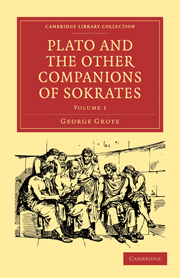Book contents
- Frontmatter
- PREFACE
- Contents
- CHAPTER I SPECULATIVE PHILOSOPHY IN GREECE, BEFORE AND IN THE TIME OF SOKRATES
- CHAPTER II GENERAL REMARKS ON THE EARLIER PHILOSOPHERS—GROWTH OF DIALECTIC—ZENO AND GORGIAS
- CHAPTER III LTFE OF PLATO
- CHAPTER IV PLATONIC CANON, AS RECOGNISED BY THRASYLLUS
- CHAPTER V PLATONIC CANON AS APPRECIATED AND MODIFIED BY MODERN CRITICS
- CHAPTER VI PLATONIC COMPOSITIONS GENERALLY
- CHAPTER VII APOLOGY OP SOKRATES
- CHAPTER VIII KRITON
- CHAPTER IX EUTHYPHRON
- CHAPTER X ALKIBIADES I. AND II.
- CHAPTER XI HIPPIAS MAJOR—HIPPIAS MINOR
- CHAPTER XII HIPPARCHUS—MINOS
- CHAPTER XIII THEAGES
- CHAPTER XIV ERASTÆ OR ANTERASTÆ—RIVALES
- CHAPTER XV ION
- CHAPTER XVI LACHES
- CHAPTER XVII CHARMIDES
- CHAPTER XVIII LYSIS
- CHAPTER XIX EUTHYDEMUS
CHAPTER VI - PLATONIC COMPOSITIONS GENERALLY
Published online by Cambridge University Press: 05 October 2010
- Frontmatter
- PREFACE
- Contents
- CHAPTER I SPECULATIVE PHILOSOPHY IN GREECE, BEFORE AND IN THE TIME OF SOKRATES
- CHAPTER II GENERAL REMARKS ON THE EARLIER PHILOSOPHERS—GROWTH OF DIALECTIC—ZENO AND GORGIAS
- CHAPTER III LTFE OF PLATO
- CHAPTER IV PLATONIC CANON, AS RECOGNISED BY THRASYLLUS
- CHAPTER V PLATONIC CANON AS APPRECIATED AND MODIFIED BY MODERN CRITICS
- CHAPTER VI PLATONIC COMPOSITIONS GENERALLY
- CHAPTER VII APOLOGY OP SOKRATES
- CHAPTER VIII KRITON
- CHAPTER IX EUTHYPHRON
- CHAPTER X ALKIBIADES I. AND II.
- CHAPTER XI HIPPIAS MAJOR—HIPPIAS MINOR
- CHAPTER XII HIPPARCHUS—MINOS
- CHAPTER XIII THEAGES
- CHAPTER XIV ERASTÆ OR ANTERASTÆ—RIVALES
- CHAPTER XV ION
- CHAPTER XVI LACHES
- CHAPTER XVII CHARMIDES
- CHAPTER XVIII LYSIS
- CHAPTER XIX EUTHYDEMUS
Summary
Variety and abundance visible in Plato's writings
On looking through the collection of works enumerated in variety and the Thrasyllean Canon, the first impression made upon us respecting the author is, that which is expressed in the epithets applied to him by Cicero—” varius et multiplex et copiosus.” Such epithets bring before us the variety in Plato's points of view and methods of handling—the multiplicity of the topics discussed—the abundance of the premisses and illustrations suggested: comparison being taken with other literary productions of the same age. It is scarcely possible to find any one predicate truly applicable to all of Plato's works. Every predicate is probably true in regard to some:—none in regard to all.
Plato both sceptical and dogmatical
Several critics of antiquity considered Plato as essentially a sceptic—that is, a Searcher or Enquirer, not reaching any assured or proved result. They denied to him the character of a dogmatist: they maintained that he neither established nor enforced any affirmative doctrines. This latter statement is carried too far. Plato is sceptical in some dialogues, dogmatical in others. And the catalogue of Thrasyllus shows that the sceptical dialogues (Dialogues of Search or Investigation) are more numerous than the dogmatical (Dialogues of Exposition)—as they are also, speaking generally, more animated and interesting.
- Type
- Chapter
- Information
- Plato and the Other Companions of Sokrates , pp. 212 - 280Publisher: Cambridge University PressPrint publication year: 2010First published in: 1865



